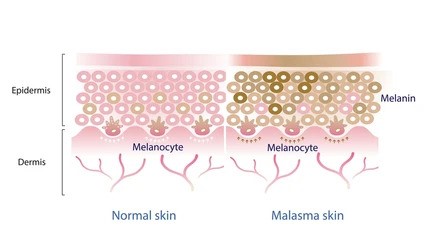Melasma

Are you sick and tired of having dark spots on your face?
Melasma is a skin hyperpigmentation condition that affects many parts of our bodies, especially our faces, and results in the development of dark patches. Both men and women can have it, but it more usually affects women during pregnancy. Melasma can be caused by a number of things, including exposure to light, hormonal effects, and genetics. Additionally, those who experience emotional distress are also impacted, which is why it’s crucial to maintain stress-free skin.
There are three layers to our skin: the epidermis, dermis, and subcutis. Melasma affects the epidermis, which is where melanocytes, cells that produce melanin (a dark pigment), are found. Melanin is produced as a result of hormonal imbalance and UV exposure. As a result, melanin production causes Melasma, or darkened skin.
Everyone needs to know that you are gorgeous and that you can flaunt your scars despite having scars all over your body. Moreover, the healthy choice clinic is here to lend you a helping hand and improve your skin if you or someone you know is dealing with this problem. We provide you with the greatest services, including consultations with board-certified experts on melasma and the necessary treatments to lessen the hyperpigmentation and dark spots that contribute to melasma.


Why do women tend to have Melasma the most?
The reason why it affects women the most may be a common subject of discussion. In response, the majority of women use oral contraceptives, such as birth control pills, which increase the body’s estrogen levels and lead to an excess of melanin, the pigment responsible for the skin’s dark tone.
Is melasma a type of cancer?
Melasma is a chronic condition that lasts for a long time, yet it is not cancerous. Although it is not a serious
disease, it must be seen by a dermatologist on a frequent basis to avoid worsening the problem.
What factors give rise to melasma?
Melasma is thought to be the result of a confluence of genetic, hormonal, and environmental variables,
while its specific etiology is yet unknown. The following are some of the most typical melasma causes:
Overall, it is believed that a variety of genetic, hormonal, and environmental variables contribute to the
development of melasma.
How can melasma be prevented?
There are various techniques to avoid developing the hyperpigmentation that causes melasma, even if
preventing melasma from happening may be difficult.
How can Melasma be cured?
Melasma is a challenging disease to cure, but there are medication alternatives and cosmetic procedures available to help decrease hyperpigmentation.
• Topical medicines: Topical medicines include sunscreen, ointments, and serum. Glossy, Glorious, Ban A Tan, and KoziMAX are ointments that can be used to cure melasma; they block the production of pigments and lighten dark areas. Similarly, Kleids Nice, Niacos, and Sebonia are serums that maintain the skin barrier and offer protection from pollution and UV rays, while Mesoestetic is a sunscreen that shields the skin from UV rays.
• Chemical Peel: chemical peel is a non-invasive process that removes the top layer of skin, which reduces the appearance of melasma.
• Pico Laser: The melanin pigment in the skin is targeted and destroyed by high-energy light in laser therapy, such as the Pico laser.
• Micro-needling with PRP: Micro-needling with PRP is a cosmetic technique that uses a medical- grade pen with small needles to create a ‘microchannel’ in the skin to regenerate new skin and reduce hyperpigmentation that causes melasma.
To summarize
Melasma is a skin hyperpigmentation disorder that causes dark spots to appear on many parts of our bodies, most notably our faces. It can affect both men and women, but it is most common in women during pregnancy.
Melasma can be avoided by following a regular skin care routine in which the medication you use should be sufficient to protect your skin from UV radiation. In addition, use of oral contraceptives should be limited.
There are several topical treatments available to treat melasma, including Glossy, Glorious, Ban A Tan, KoziMAX, Niacos, Sebonia, Mesoestetic, and Kleida Nice.

